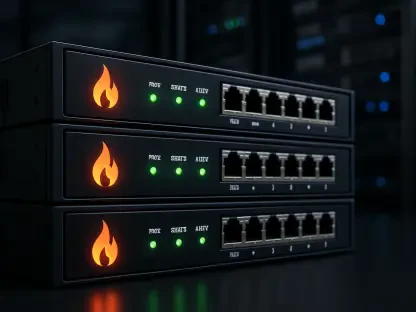The dawn of liquid-cooled AI data centers marks a significant technological shift in the IT industry, driven by the need for more efficient and sustainable infrastructure solutions. As enterprises increasingly depend on AI-driven applications to power their operations, the demand for energy-efficient, environmentally friendly data centers has never been higher. These facilities are engineered to handle the immense heat outputs and energy requirements inherent in AI workloads, providing a holistic approach to managing complex IT environments. This article examines recent developments, potential growth, and the technology behind these cutting-edge data centers.
The Rise of Liquid Cooling in AI Data Centers
Understanding Liquid Cooling Systems
Liquid cooling systems have emerged as a transformative technology in data center operations, specifically tailored to meet the cooling demands of intense AI workloads. Unlike traditional air cooling methods, liquid cooling utilizes a specialized fluid to directly absorb and dissipate heat from crucial components like GPUs and CPUs. This process not only efficiently manages higher thermal loads but also minimizes physical space requirements in data centers. With AI applications requiring substantial computational capabilities, the direct removal of heat from chips is essential for maintaining optimal performance and preventing thermal throttling. The ability to eliminate heat with precision makes liquid cooling a preferred choice for modern data centers aiming to increase their operational efficiency and sustainability.
Moreover, liquid-cooled systems are designed to offer customizable solutions that can be tailored to specific workload requirements. These systems cater to varying thermal budgets, enabling operators to implement just the right amount of cooling necessary to keep their infrastructure running smoothly. This modular approach ensures that data centers can scale their cooling solutions in line with the fluctuating demands of their AI applications. Additionally, liquid cooling contributes to a reduced carbon footprint by significantly lowering energy consumption compared to air cooling systems. As organizations strive to meet stringent environmental standards and sustainability goals, liquid cooling offers an effective means to reduce energy costs while supporting the expansive growth of AI technologies.
Benefits of Liquid-Cooled AI Facilities
The implementation of liquid-cooled AI data centers offers several substantial advantages that make them integral to the future of IT infrastructure. Foremost among these is improved energy efficiency. Liquid cooling systems can save up to 40% of power consumption compared to traditional cooling methods, directly impacting operational costs and environmental footprints. By prioritizing energy efficiency, organizations can align their infrastructure with increasingly stringent environmental regulations while optimizing expenses. Furthermore, the streamlined design of liquid-cooled data centers ensures a reduction in physical footprint, with claims of up to 60% less space occupied, allowing enterprises to maximize their real estate investments.
Additionally, liquid-cooled facilities are engineered to provide consistent reliability and performance under the intense demands of AI operations. These systems can manage workloads that produce high thermal outputs and energy requirements, ensuring that performance is sustained without overheating or interruptions. Such reliability is crucial for applications where stability and uptime are critical, including financial modeling, autonomous vehicles, and complex simulations. By offering a superior thermal management solution, liquid-cooled data centers facilitate enhanced computational capabilities, paving the way for more intricate AI-driven projects without compromising on operational consistency.
Supermicro’s Revolutionary Data Center Building Block Solutions
Introducing the DCBBS Framework
Supermicro’s Data Center Building Block Solutions® (DCBBS) represents an innovative advancement tailored to ease the intricate processes associated with designing and deploying AI-ready data centers. This framework offers a comprehensive package that encompasses all vital components, ranging from computing systems to cooling infrastructure, in an integrated and scalable solution. Central to DCBBS is its capacity to streamline design, construction, deployment, and functional phases, promising expedited timelines and simplified operations. The system is built on standardized yet adaptable architecture, facilitating seamless integration across various facilities and minimizing disruptions during deployment.
DCBBS’s modular approach to data center construction presents significant advantages in terms of flexibility and customization. Clients can opt for pre-validated units designed to meet specific project criteria, including extensive configuration options related to floor plans, rack elevations, and hardware specifications. This customization enables enterprises to adapt and scale their AI infrastructure according to evolving requirements, such as heightened computing demands or specialized workload needs. With a selection process tailored to individual project specifications, enterprises can benefit from more efficient, targeted infrastructure strategies that align with cost and performance objectives.
Efficiency and Environmental Impact
One of the most impactful characteristics of Supermicro’s DCBBS is its commitment to reducing environmental impacts through cutting-edge cooling technologies. The integration of Direct Liquid Cooling (DLC-2) technology offers considerable savings in energy consumption, allowing facilities to achieve up to 40% power reduction compared to conventional cooling methods. This focus on energy conservation not only lowers operational costs but also aligns with corporate sustainability strategies, reducing carbon footprints and contributing positively to environmental goals. Moreover, DLC-2 technology drastically minimizes water usage, offering a 40% reduction in consumption—a vital consideration given global concerns over resource conservation.
Additionally, DCBBS addresses operational efficiency through its modular design, which aids in optimizing data center layouts and cooling arrangements, reducing overall space requirements by up to 60%. This minimized footprint enables enterprises to better utilize their physical assets and streamline processes more effectively. By concentrating resources on high-density workloads and using liquid cooling systems that directly address heat generation points, these data centers can achieve greater economies of scale and decreased total cost of ownership (TCO). As a result, organizations can operate more sustainably and profitably, navigating future technological challenges with enhanced agility and foresight.
Supporting Services and Infrastructure Management
Hierarchical Customization and Expert Support
Supermicro has extended its innovation to supporting services that complement their DCBBS offerings. These services play a crucial role in maximizing infrastructure potential, ranging from initial consultations and design validation to deployment and operational support. By providing expert guidance throughout all phases of a project, from conception to execution, Supermicro ensures that clients receive tailored solutions that meet unique operational demands. The expertise offered in these services bolsters DCBBS’s flexibility by enabling comprehensive customization at every stage, ensuring infrastructure is adaptable to specific hardware requirements and applications.
Moreover, the hierarchical customization within DCBBS is crucial for aligning data center operations with performance targets, power budgets, and environmental goals. Supermicro’s commitment to quality and efficiency is reflected in the careful design of rack-level architectures, accommodating various configurations and optimal thermal and cabling strategies. By adapting rack designs to match workflow intricacies, enterprises can maximize space and cooling efficiency, ensuring specific component needs are met without unnecessary resource allocation. This attention to detail supports operational robustness, catering to the demands of high-performance AI applications and positioning organizations for long-term infrastructure resilience.
Advanced Infrastructure Management Tools
Supermicro has integrated advanced infrastructure management solutions within its DCBBS framework to enhance oversight and operational efficiency. The SuperCloud Composer® platform offers robust analytics capabilities that facilitate comprehensive management at a cloud scale, ensuring streamlined operations across computing, storage, and networking domains. By leveraging sophisticated tools for monitoring and optimizing various facets of infrastructure, organizations can gain valuable insights into system performance, resource allocation, and potential vulnerabilities. These analytics capabilities empower data center operators to make informed decisions, proactively addressing issues before they impact operations and maintaining consistent service delivery.
Furthermore, the SuperCloud Composer® strengthens operational transparency by enabling real-time tracking and predictive analytics that inform strategic and tactical planning. This level of oversight aids organizations in anticipating future infrastructure needs, adapting to changing workload demands, and proactively optimizing resource distribution to maintain efficiency and minimize downtime. By using advanced management tools alongside DCBBS’s flexible framework, enterprises can achieve a harmonious balance between cutting-edge performance and sustainable operations, supporting the evolving landscape of AI-driven technologies with confidence and competence.
The Future of AI Data Centers
Promoting Widespread Adoption
The traction gained by liquid-cooled AI data centers indicates a significant shift in the industry’s approach to managing computing-intensive environments. With mounting pressure from regulatory bodies to embrace eco-friendly practices and prioritize energy efficiency, the adoption of these advanced cooling technologies is poised to become more prevalent. As enterprises increasingly turn to AI applications to drive innovation and operational efficiencies, the necessity for sophisticated infrastructure solutions will only continue to grow. Liquid-cooled data centers, with their promise of operational reliability, efficiency, and environmental sustainability, are positioned as a viable solution for meeting these demands.
The pivot towards liquid cooling is being supported by advancements in global infrastructure that allow for seamless integration with existing systems. Leading technology providers such as Supermicro have paved the way for liquid-cooled data centers by developing comprehensive solutions that simplify deployment and minimize disruption. Businesses that choose to adopt liquid cooling early will benefit from optimized performance and enhanced competitive edge, capitalizing on the substantial rate at which AI applications are expected to scale. The groundwork laid now will determine the future trajectory of AI infrastructure, with liquid-cooled systems playing a pivotal role in shaping efficient, sustainable data center ecosystems globally.
Navigating Future Challenges and Opportunities
As the IT landscape continues to evolve, liquid-cooled AI data centers face several challenges that require strategic consideration and planning. The scaling of AI applications introduces complexities in workload management and infrastructure allocation, requiring robust solutions to ensure consistent service delivery. The need for adaptability is paramount as enterprises explore emerging technologies such as edge computing and big data analytics, demanding infrastructure capable of handling diverse operational needs. Liquid cooling technologies offer a pathway to navigate these challenges by providing flexible solutions that adapt to evolving requirements.
Strategic investment in liquid-cooled data centers will empower organizations to leverage opportunities presented by AI innovation, enhancing their ability to stay ahead of competitors and remain responsive to market demands. The push towards greater sustainability aligns with broader industry trends, offering a platform for enterprises to differentiate themselves through responsible practices. By prioritizing energy efficiency and environmental impact reductions, these data centers can foster growth not only in infrastructure capabilities but also in corporate reputation and client expectations. The forward-looking stance embraced by liquid-cooled AI facilities paves the way for significant advancements in data center design and management that will influence future technological landscapes.
Conclusion: The Dawn of a New Era in IT Infrastructure
The advent of liquid-cooled AI data centers signifies a substantial shift in the IT sector, driven by the urgency for infrastructure that is both effective and sustainable. As businesses rely more on AI-driven applications to enhance their operations, the need for data centers that prioritize energy efficiency and environmental consciousness has soared. These facilities are meticulously designed to manage the considerable heat outputs and energy demands typical of AI workloads. The approach not only addresses cooling issues but also optimizes the storage and processing of AI data, fostering a more comprehensive IT environment. This progressive trend in data center technology opens avenues for new developments, positioning them for potential expansion and refining AI’s role in business processes. Such initiatives are reshaping how IT infrastructures are developed, underscoring the significance of integrating environmentally friendly practices in tech innovation. They offer insights into the future of AI efficiencies and environmental considerations.









